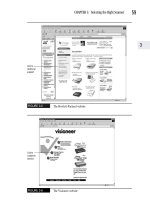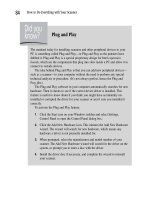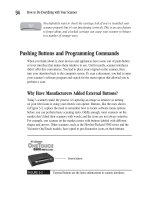How to do everything with PHP (phần 4) ppt
Bạn đang xem bản rút gọn của tài liệu. Xem và tải ngay bản đầy đủ của tài liệu tại đây (1.1 MB, 50 trang )
134 How to Do Everything with PHP & MySQL
HowTo8 (8) / How to Do Everything with PHP & MySQL/Vaswani/225795-4/Chapter 7
HowTo8 (8) / How to Do Everything with PHP & MySQL/Vaswani/225795-4/Chapter 7
N
ow that you can find your way around a PHP script, it’s time to start writing
your own. This chapter brings the basic PHP course taught over the last few
chapters to a logical conclusion, by attempting to use as many of the constructs
and techniques taught over the previous pages to create a working application. This
example is, of necessity, somewhat contrived, but I hope you find it interesting.
How to…
■ Create a web-based shopping cart
■ Read and display a product catalog from a text file
■ Store item quantities in a session, and perform calculations on them
Understanding Requirements
The application here is a web-based shopping cart that uses PHP’s built-in session-
management support to track the items selected for purchase by a user. Items are
listed in a product catalog, and the user has the ability to select custom quantities
of each item using an HTML form. The selected items then appear in the user’s
“cart,” with item subtotals automatically calculated from the quantity and unit
price. Users can clear their carts of all selected items, or selectively update the
quantities to be purchased of each item; the totals are recalculated automatically.
The catalog itself is read from a text file; this file contains a list of product IDs,
descriptions, and unit prices.
If all this seems somewhat daunting, fear not—it’s pretty simple, once you
break it down.
Retrieving Catalog Data
Let’s begin with the catalog file itself and examine the format in which catalog data
is stored:
101:AA batteries (pack of 2):2.99
102:AA batteries (pack of 4):5.49
103:Backpack (black): 69.99
104:Money belt with 6 compartments (black):13.49
105:Haversack (red):199.99
106:Swiss Army knife (6 blades including can opener and scissors):24.99
107:Duffel bag (steel gray):28.50
ch07.indd 134 2/2/05 3:12:34 PM
TEAM LinG
HowTo8 (8)
CHAPTER 7: Sample Application: Session-Based Shopping Cart 135
HowTo8 (8)
This is fairly easy to understand: each product is listed on a separate line, with
colons used to demarcate the product code or SKU, its description, and its price. It’s
easy to parse this file and store its contents in a PHP array using the file() and
explode() functions. And this next snippet of code does exactly that:
<?php
// look for catalog file
$catalogFile = "catalog.dat";
// file is available, extract data from it
// place into $CATALOG array, with SKU as key
if (file_exists($catalogFile))
{
$data = file($catalogFile);
foreach ($data as $line)
{
$lineArray = explode(':', $line);
$sku = trim($lineArray[0]);
$CATALOG[$sku]['desc'] = trim($lineArray[1]);
$CATALOG[$sku]['price'] = trim($lineArray[2]);
}
}
else
{
die("Could not find catalog file");
}
?>
The end result of this is an associative array called $CATALOG, which uses the
product codes as keys. Each key further points to a nested associative array with two
keys—desc and price—which the product’s description and price, respectively.
This $CATALOG array, once created, becomes available for use by other components
within the script. Obviously, in the event that the catalog file cannot be found, the user
must be notified with an error message, hence, the if(file_exists( )) test
and subsequent call to die() if the test proves false.
Once the catalog data is successfully imported into a PHP variable, the next
step is to print it. Because the data is in an array, it’s logical to reach for the
foreach() loop to process it. Here’s the code:
<table border="0" cellspacing="10">
<?php
// print items from the catalog for selection
7
ch07.indd 135 2/2/05 3:12:35 PM
TEAM LinG
136 How to Do Everything with PHP & MySQL
HowTo8 (8) / How to Do Everything with PHP & MySQL/Vaswani/225795-4/Chapter 7
HowTo8 (8) / How to Do Everything with PHP & MySQL/Vaswani/225795-4/Chapter 7
foreach ($CATALOG as $k => $v)
{
echo "<tr><td colspan=2>";
echo "<b>" . $v['desc'] . "</b>";
echo "</td></tr>\n";
echo "<tr><td>";
echo "Price per unit: " . $CATALOG[$k]['price'];
echo "</td><td>Quantity: ";
echo "<input size=4 type=text name=\"a_qty[" . $k . "]\">";
echo "</td></tr>\n";
}
?>
<tr>
<td colspan="2">
<input type="submit" name="add" value="Add items to cart">
</td>
</tr>
</table>
Notice that each item in the product catalog contains an empty text field next
to it, which can be used to input quantities. The data entered into these fields is
submitted back to the same script, by means of a POST-ed array called $a_qty.
The keys of this array are the product codes, and its values are the corresponding
quantities selected.
Creating the Shopping Cart
On submission, the items and quantities selected need to find their way into
the “shopping cart”—essentially, a session variable that remains available
throughout the user’s session. This shopping cart is an associative array called
$_SESSION['cart']. Its keys are the product codes of the selected items,
and its values are the corresponding quantities entered by the user.
<?php
session_start();
if ($_POST['add'])
{
foreach ($_POST['a_qty'] as $k => $v)
{
$_SESSION['cart'][$k] = $_SESSION['cart'][$k] + $v;
}
}
?>
ch07.indd 136 2/2/05 3:12:35 PM
TEAM LinG
HowTo8 (8)
CHAPTER 7: Sample Application: Session-Based Shopping Cart 137
HowTo8 (8)
Note that for items already in the cart, submitting the form with new numbers
adds to the existing quantities, instead of replacing them.
Calculating Costs
Once items have been stored in the shopping cart, it’s a simple matter to display
them. All you need to do is iterate over the $_SESSION['cart'] array and
print its values. Because $_SESSION['cart'] only stores product codes with
quantities, it’s necessary to cross-reference the product codes with the data in the
$CATALOG array to retrieve the human-readable descriptions and prices (these
prices are also used to calculate subtotals and the grand total).
<table width="100%" border="0" cellspacing="10">
<?php
// initialize a variable to hold total cost
$total = 0;
// check the shopping cart
// if it contains values
// look up the SKUs in the $CATALOG array
// get the cost and calculate subtotals and totals
if (is_array($_SESSION['cart']))
{
foreach ($_SESSION['cart'] as $k => $v)
{
if ($v > 0)
{
$subtotal = $v * $CATALOG[$k]['price'];
$total += $subtotal;
echo "<tr><td>";
echo "<b>$v unit(s) of " . $CATALOG[$k]['desc'] ↵
. "</b>";
echo "</td><td>";
echo "New quantity: <input size=4 type=text ↵
name=\"u_qty[" . $k . "]\">";
echo "</td></tr>\n";
echo "<tr><td>";
echo "Price per unit: " . $CATALOG[$k]['price'];
echo "</td><td>";
echo "Sub-total: " . sprintf("%0.2f", $subtotal);
echo "</td></tr>\n";
}
}
}
7
ch07.indd 137 2/2/05 3:12:35 PM
TEAM LinG
138 How to Do Everything with PHP & MySQL
HowTo8 (8) / How to Do Everything with PHP & MySQL/Vaswani/225795-4/Chapter 7
HowTo8 (8) / How to Do Everything with PHP & MySQL/Vaswani/225795-4/Chapter 7
?>
<tr>
<td><b>TOTAL</b></td>
<td><b><?=sprintf("%0.2f", $total)?></b></td>
</tr>
<tr>
<td><input type="submit" name="update" value="Update Cart"></td>
<td><input type="submit" name="clear" value="Clear Cart"></td>
</tr>
</table>
Handling Cart Updates
This display contains a text field next to each item, for the user to update the
quantities of each item in the cart. Values are submitted to the form processor
through the $u_qty array (similar in structure to the $a_qty array explained
earlier). This update operation differs from the add operation in that submitting
the form with new values replaces the existing quantities (instead of adding to
them). The user also has the option of “emptying” the cart with a single click;
essentially, this destroys the session data and presents the user with an empty
$_SESSION['cart'] array.
Here’s the code to perform the previous logic:
<?php
if ($_POST['update'])
Sprinting Ahead
In case you were wondering, the sprintf() function is used to massage
numbers into user-defined formats. It enables you to format the padding,
alignment, and precision of a number using predefined format specifiers, in
a manner similar to the date() function. Read more about it at http://www
.php.net/manual/en/function.sprintf.php.
ch07.indd 138 2/2/05 3:12:36 PM
TEAM LinG
HowTo8 (8)
CHAPTER 7: Sample Application: Session-Based Shopping Cart 139
HowTo8 (8)
foreach ($_POST['u_qty'] as $k => $v)
{
$_SESSION['cart'][$k] = $v;
}
}
// if this is a clear operation
// reset the session and the cart
// destroy all session data
if ($_POST['clear'])
{
$_SESSION = array();
session_destroy();
}
?>
Putting It All Together
And now that you’ve seen how the various pieces interact with each other, here’s
the complete script:
<?php
// start session
session_start();
// initialize session shopping cart
if (!isset($_SESSION['cart']))
{
$_SESSION['cart'] = array();
}
// look for catalog file
$catalogFile = "catalog.dat";
// file is available, extract data from it
// place into $CATALOG array, with SKU as key
if (file_exists($catalogFile))
{
$data = file($catalogFile);
foreach ($data as $line)
{
$lineArray = explode(':', $line);
$sku = trim($lineArray[0]);
7
ch07.indd 139 2/2/05 3:12:36 PM
TEAM LinG
140 How to Do Everything with PHP & MySQL
HowTo8 (8) / How to Do Everything with PHP & MySQL/Vaswani/225795-4/Chapter 7
HowTo8 (8) / How to Do Everything with PHP & MySQL/Vaswani/225795-4/Chapter 7
$CATALOG[$sku]['desc'] = trim($lineArray[1]);
$CATALOG[$sku]['price'] = trim($lineArray[2]);
}
}
// file is not available
// stop immediately with an error
else
{
die("Could not find catalog file");
}
// check to see if the form has been submitted
// and which submit button was clicked
// if this is an add operation
// add to already existing quantities in shopping cart
if ($_POST['add'])
{
foreach ($_POST['a_qty'] as $k => $v)
{
// if the value is 0 or negative
// don't bother changing the cart
if ($v > 0)
{
$_SESSION['cart'][$k] = $_SESSION['cart'][$k] + $v;
}
}
}
// if this is an update operation
// replace quantities in shopping cart with values entered
else if ($_POST['update'])
{
foreach ($_POST['u_qty'] as $k => $v)
{
// if the value is empty, 0 or negative
// don't bother changing the cart
if ($v != "" && $v >= 0)
{
$_SESSION['cart'][$k] = $v;
}
}
}
ch07.indd 140 2/2/05 3:12:36 PM
TEAM LinG
HowTo8 (8)
CHAPTER 7: Sample Application: Session-Based Shopping Cart 141
HowTo8 (8)
// if this is a clear operation
// reset the session and the cart
// destroy all session data
else if ($_POST['clear'])
{
$_SESSION = array();
session_destroy();
}
?>
<html>
<head></head>
<body>
<h2>Catalog</h2>
Please add items from the list below to your shopping cart.
<form action="<?=$_SERVER['PHP_SELF']?>" method="post">
<table border="0" cellspacing="10">
<?php
// print items from the catalog for selection
foreach ($CATALOG as $k => $v)
{
echo "<tr><td colspan=2>";
echo "<b>" . $v['desc'] . "</b>";
echo "</td></tr>\n";
echo "<tr><td>";
echo "Price per unit: " . $CATALOG[$k]['price'];
echo "</td><td>Quantity: ";
echo "<input size=4 type=text name=\"a_qty[" . $k . "]\">";
echo "</td></tr>\n";
}
?>
<tr>
<td colspan="2">
<input type="submit" name="add" value="Add items to cart">
</td>
</tr>
</table>
<hr />
<hr />
7
ch07.indd 141 2/2/05 3:12:36 PM
TEAM LinG
142 How to Do Everything with PHP & MySQL
HowTo8 (8) / How to Do Everything with PHP & MySQL/Vaswani/225795-4/Chapter 7
HowTo8 (8) / How to Do Everything with PHP & MySQL/Vaswani/225795-4/Chapter 7
<h2>Shopping cart</h2>
<table width="100%" border="0" cellspacing="10">
<?php
// initialize a variable to hold total cost
$total = 0;
// check the shopping cart
// if it contains values
// look up the SKUs in the $CATALOG array
// get the cost and calculate subtotals and totals
if (is_array($_SESSION['cart']))
{
foreach ($_SESSION['cart'] as $k => $v)
{
// only display items that have been selected
// that is, quantities > 0
if ($v > 0)
{
$subtotal = $v * $CATALOG[$k]['price'];
$total += $subtotal;
echo "<tr><td>";
echo "<b>$v unit(s) of " . $CATALOG[$k]['desc'] ↵
. "</b>";
echo "</td><td>";
echo "New quantity: <input size=4 type=text ↵
name=\"u_qty[" . $k . "]\">";
echo "</td></tr>\n";
echo "<tr><td>";
echo "Price per unit: " . $CATALOG[$k]['price'];
echo "</td><td>";
echo "Sub-total: " . sprintf("%0.2f", $subtotal);
echo "</td></tr>\n";
}
}
}
?>
<tr>
<td><b>TOTAL</b></td>
<td><b><?=sprintf("%0.2f", $total)?></b></td>
</tr>
ch07.indd 142 2/2/05 3:12:36 PM
TEAM LinG
HowTo8 (8)
CHAPTER 7: Sample Application: Session-Based Shopping Cart 143
HowTo8 (8)
<tr>
<td><input type="submit" name="update" value="Update Cart"></td>
<td><input type="submit" name="clear" value="Clear Cart"></td>
</tr>
</table>
</form>
</body>
</html>
Pop it into your browser, and see how it works. When you first load it up,
you’ll see a list of items, like in Figure 7-1.
Select a few items by attaching quantities to them, and submit the form. The
page will refresh and display those items to you in your shopping cart, together
with unit and total costs. Figure 7-2 shows what this might look like.
FIGURE 7-1 Selection list
7
ch07.indd 143 2/2/05 3:12:37 PM
TEAM LinG
144 How to Do Everything with PHP & MySQL
HowTo8 (8) / How to Do Everything with PHP & MySQL/Vaswani/225795-4/Chapter 7
HowTo8 (8) / How to Do Everything with PHP & MySQL/Vaswani/225795-4/Chapter 7
Because the shopping cart is maintained in a session, your selection will be
“remembered” even if you visit another site, and then come back to the page.
The session will only be destroyed if you close your browser window, or if you
explicitly empty your cart by calling the session_destroy() function.
Summary
This chapter was designed to demonstrate a practical application of PHP: creating
a simple session-based shopping-cart application. This application used many of
the structures and techniques—arithmetic operators, conditional statements, loops,
arrays, sessions, file manipulation, and form processing—taught in earlier sections
of the chapter, and if you were able to understand it, you’re all set to start creating
your own PHP scripts.
FIGURE 7-2 Your shopping cart
ch07.indd 144 2/2/05 3:12:37 PM
TEAM LinG
HowTo8 (8)
CHAPTER 7: Sample Application: Session-Based Shopping Cart 145
HowTo8 (8)
Two great ways of improving your knowledge of PHP scripting are by reading
case studies and analyzing the code of your peers. To this end, consider visiting the
following links, all of which contain case studies and sample PHP code from real-
world applications:
■ A polling system, at />trog/article.php?id=59
■ Web-based file management systems, at />community/columns/trog/article.php?id=64 and />gollem/
■ A web-based e-mail client, at />columns/trog/article.php?id=100
■ An advertiser/banner management system for web sites, at http://www
.phpadsnew.com/
■ A threaded discussion forum, at />■ A content management and personalization system for web sites, at http://
www.php-nuke.org/
■ Articles and tutorials on PHP, at />columns/trog/archives.php?category=PHP
The next few chapters look at the other half of the PHP-MySQL combo,
teaching you what MySQL is, and how to use it for data storage and retrieval.
7
ch07.indd 145 2/2/05 3:12:37 PM
TEAM LinG
ch07.indd 146 2/2/05 3:12:37 PM
This page is intentionally left blank.
TEAM LinG
Part III
HowTo8 (8)
Learning
MySQL
ch08.indd 147 2/2/05 3:13:53 PM
Copyright © 2005 by The McGraw-Hill Companies. Click here for terms of use.
TEAM LinG
ch08.indd 148 2/2/05 3:13:53 PM
This page is intentionally left blank.
TEAM LinG
Chapter 8
HowTo8 (8)
Understanding
an RDBMS
ch08.indd 149 2/2/05 3:13:54 PM
Copyright © 2005 by The McGraw-Hill Companies. Click here for terms of use.
TEAM LinG
150 How to Do Everything with PHP & MySQL
HowTo8 (8) / How to Do Everything with PHP & MySQL/Vaswani/225795-4/Chapter 8
HowTo8 (8) / How to Do Everything with PHP & MySQL/Vaswani/225795-4/Chapter 8
A
ccording to its official web site, MySQL is “the world’s most popular open-source
database.” That’s no small claim, but the numbers seem to back it up: today,
over five million sites are creating, using, and deploying MySQL or MySQL-based
applications. There are numerous reasons for this popularity: the server is fast and
scalable, offers all the features and reliability of commercial-grade competitors,
comes with a customer-friendly licensing policy, and is simple to learn and use.
It’s also well suited for development—the PHP programming language has supported
MySQL since its early days, and the PHP-MySQL combination has become
extremely popular for building database-driven web applications.
The previous chapters showed you the basics of PHP scripting, with discussions
of PHP syntax and examples of common techniques you’ll use when building
PHP-based applications. This chapter focuses on the other half of the PHP-MySQL
combo, giving you a crash course in basic RDBMS concepts and introducing you
to the MySQL command-line client. In case you’ve never used a database before
or the thought of learning another language scares you, don’t worry, because
MySQL is quite friendly and you should have no trouble learning how to use it.
How to…
■ Organize data into fields, records, and tables
■ Identify records uniquely with primary keys
■ Connect records in different tables through common fields
■ Understand the three components of Structured Query Language (SQL)
■ Write simple SQL statements
■ Gain the benefits of normalized databases
■ Send commands to, and receive responses from, MySQL with the
command-line MySQL client
Understanding a Relational Database
You may remember from the introductory notes in Chapter 1 that an electronic
database management system (DBMS) is a tool that helps you organize information
efficiently, so it becomes easier to find exactly what you need. A relational database
ch08.indd 150 2/2/05 3:13:54 PM
TEAM LinG
HowTo8 (8)
CHAPTER 8: Understanding an RDBMS 151
HowTo8 (8)
management system (RDBMS) like MySQL takes things a step further, by enabling
you to create links between the various pieces of data in a database, and then use
the relationships to analyze the data in different ways.
Now, while this is wonderful theory, it is still just that: theory. To truly understand
how a database works, you need to move from abstract theoretical concepts to
practical real-world examples. This section does just that, by creating a sample
database and using it to explain some of the basic concepts you must know before
proceeding further.
Understanding Tables, Records, and Fields
Every database is composed of one or more tables. These tables, which structure
data into rows and columns, are what lend organization to the data.
Here’s an example of what a typical table looks like:
+ + + +
| mid | mtitle | myear |
+ + + +
| 1 | Rear Window | 1954 |
| 2 | To Catch A Thief | 1955 |
| 3 | The Maltese Falcon | 1941 |
| 4 | The Birds | 1963 |
| 5 | North By Northwest | 1959 |
| 6 | Casablanca | 1942 |
| 7 | Anatomy Of A Murder | 1959 |
+ + + +
As you can see, a table divides data into rows, with a new entry (or record) on
every row. The data in each row is further broken down into columns (or fields),
each of which contains a value for a particular attribute of that data. For example,
if you consider the record for the movie Rear Window, you’ll see that the record
is clearly divided into separate fields for the row number, the movie title, and the
year in which it was released.
Think of a table as a drawer containing files. A record is the electronic
representation of a file in the drawer.
Understanding Primary and Foreign Keys
Records within a table are not arranged in any particular order—they can be
sorted alphabetically, by ID, by member name, or by any other criteria you choose
8
ch08.indd 151 2/2/05 3:13:55 PM
TEAM LinG
152 How to Do Everything with PHP & MySQL
HowTo8 (8) / How to Do Everything with PHP & MySQL/Vaswani/225795-4/Chapter 8
HowTo8 (8) / How to Do Everything with PHP & MySQL/Vaswani/225795-4/Chapter 8
to specify. Therefore, it becomes necessary to have some method of identifying
a specific record in a table. In the previous example, each record is identified by
a unique number and this unique field is referred to as the primary key for that
table. Primary keys don’t appear automatically; you have to explicitly mark a field
as a primary key when you create a table.
Think of a primary key as a label on each file, which tells you what it
contains. In the absence of this label, the files would all look the same
and it would be difficult for you to identify the one(s) you need.
With a relational database system like MySQL, it’s also possible to link
information in one table to information in another. When you begin to do this,
the true power of an RDBMS becomes evident. So let’s add two more tables, one
listing important actors and directors, and the other linking them to movies.
+ + + + +
| pid | pname | psex | pdob |
+ + + + +
| 1 | Alfred Hitchcock | M | 1899-08-13 |
| 2 | Cary Grant | M | 1904-01-18 |
| 3 | Grace Kelly | F | 1929-11-12 |
| 4 | Humphrey Bogart | M | 1899-12-25 |
| 5 | Sydney Greenstreet | M | 1879-12-27 |
| 6 | James Stewart | M | 1908-05-20 |
+ + + + +
+ + + +
| mid | pid | role |
+ + + +
| 1 | 1 | D |
| 1 | 3 | A |
| 1 | 6 | A |
| 2 | 1 | D |
| 2 | 2 | A |
| 2 | 3 | A |
| 3 | 4 | A |
| 3 | 5 | A |
| 4 | 1 | D |
| 5 | 1 | D |
| 5 | 2 | A |
| 6 | 4 | A |
+ + + +
ch08.indd 152 2/2/05 3:13:55 PM
TEAM LinG
HowTo8 (8)
CHAPTER 8: Understanding an RDBMS 153
HowTo8 (8)
If you take a close look at the third table, you’ll see that it links each movie with
the people who participated in it, and it also indicates if they were actors (A) or
directors (D). Thus, you can see that Rear Window (movie #1) was directed by
Alfred Hitchcock (person #1), with Grace Kelly (person #3) and James Stewart
(person #6) as actors. Similarly, you can see that Cary Grant (person #2) acted
in two movies in the list, To Catch A Thief (movie #2) and North By Northwest
(movie #5).
To understand these relationships visually, look at Figure 8-1.
The third table sets up a relationship between the first and second table, by linking
them together using common fields. Such relationships form the foundation of
a relational database system. The common fields used to link the tables together
Invasion of the Foreign Keys
Referential integrity is a basic concept with an RDBMS, and one that becomes
important when designing a database with more than one table. When foreign
keys are used to link one table to another, referential integrity, by its nature,
imposes constraints on inserting new records and updating existing records. For
example, if a table only accepts certain types of values for a particular field,
and other tables use that field as their foreign key, this automatically imposes
certain constraints on the dependent tables. Similarly, referential integrity
demands that a change in the field used as a foreign key—a deletion or new
insertion—must immediately be reflected in all dependent tables.
Many of today’s databases take care of this automatically—if you’ve worked
with Microsoft Access, for example, you’ll have seen this in action—but some
don’t. In the case of the latter, the task of maintaining referential integrity becomes
a manual one, in which the values in all dependent tables have to be manually
updated whenever the value in the primary table changes. Because using
foreign keys can degrade the performance of your RDBMS, MySQL leaves
the choice of activating such automatic updates (and losing some measure of
performance) or deactivating foreign keys (and gaining the benefits of greater
speed) to the developer, by making it possible to choose a different type for
each table.
8
ch08.indd 153 2/2/05 3:13:55 PM
TEAM LinG
154 How to Do Everything with PHP & MySQL
HowTo8 (8) / How to Do Everything with PHP & MySQL/Vaswani/225795-4/Chapter 8
HowTo8 (8) / How to Do Everything with PHP & MySQL/Vaswani/225795-4/Chapter 8
are called foreign keys, and when every foreign key value is related to a field
in another table, this relationship being unique, the system is said to be in a state of
referential integrity. In other words, if the mid field is present once and only once
in each table that uses it, and if a change to the mid field in any single table is
reflected in all other tables, referential integrity is said to exist.
Once one or more relationships are set up between tables, it is possible to
extract a subset of the data (a data slice) to answer specific questions. The act of
pulling out this data is referred to as a query, and the resulting data is referred to
as a result set. And it’s in creating these queries, as well as in manipulating the
database itself, that SQL truly comes into its own.
Understanding SQL and SQL Queries
Putting data into a database is only half the battle—the other half involves using
it effectively. This section tells you a little bit about SQL, which is the primary
means of communicating with a database and extracting the data you require.
SQL began life as SEQUEL, the Structured English Query Language; the name
was later changed to SQL for legal reasons. SEQUEL was a part of System/R,
a prototype of the first relational database system created by IBM in 1974. In the late
1970s, SQL was selected as the query language for the Oracle RDBMS. This put it
on the map and, by the 1980s, SQL was used in almost all commercial RDBMS. In
1989, SQL became an ANSI standard. The latest version of this standard, referred
to as SQL92 or SQL2, is currently used on most of today’s commercial RDBMSs
(including MySQL).
FIGURE 8-1 The interrelationships among movies, actors, and directors
ch08.indd 154 2/2/05 3:13:56 PM
TEAM LinG
HowTo8 (8)
CHAPTER 8: Understanding an RDBMS 155
HowTo8 (8)
SQL statements resemble spoken English and can broadly be classified into
three categories:
■ Data Definition Language (DDL) DDL consists of statements that
define the structure and relationships of a database and its tables. Typically,
these statements are used to create, delete, and modify databases and tables;
specify field names and types; set indexes; and establish relationships
between tables.
■ Data Manipulation Language (DML) DML statements are related to
altering and extracting data from a database. These statements are used
to add records to, and delete records from, a database; perform queries;
retrieve table records matching one or more user-specified criteria; and join
tables together using their common fields.
■ Data Control Language (DCL) DCL statements are used to define
access levels and security privileges for a database. You would use these
statements to grant or deny user privileges, assign roles, change passwords,
view permissions, and create rulesets to protect access to data.
When creating applications with PHP and MySQL, you’ll mostly be using
DML statements.
Here are a few examples of valid SQL statements:
CREATE DATABASE addressbook;
DESCRIBE catalog;
SELECT title FROM books WHERE targetAge > 3;
DELETE FROM houses WHERE area < 100;
As the previous examples demonstrate, SQL syntax is close to spoken English,
which is why most novice programmers find it easy to learn and use. Every SQL
statement begins with an “action word” and ends with a semicolon. White space,
tabs, and carriage returns are ignored. This makes the following two commands
equivalent:
DELETE FROM houses WHERE monthlyRent > 25000;
DELETE FROM
houses
WHERE monthlyRent >
25000;
8
ch08.indd 155 2/2/05 3:13:56 PM
TEAM LinG
156 How to Do Everything with PHP & MySQL
HowTo8 (8) / How to Do Everything with PHP & MySQL/Vaswani/225795-4/Chapter 8
HowTo8 (8) / How to Do Everything with PHP & MySQL/Vaswani/225795-4/Chapter 8
Understanding Database Normalization
An important part of designing a database is a process known as normalization.
Normalization refers to the activity of streamlining a database design by eliminating
redundancies and repeated values. Most often, redundancies are eliminated by
placing repeating groups of values into separate tables and linking them through
foreign keys. This not only makes the database more compact and reduces the disk space
it occupies, but it also simplifies the task of making changes. In nonnormalized
databases, because values are usually repeated in different tables, altering them
is a manual (and error-prone) find-and-replace process. In a normalized database,
because values appear only once, making changes is a simple one-step UPDATE.
The normalization process also includes validating the database relationships to
ensure that there aren’t any crossed wires and to eliminate incorrect dependencies.
This is a worthy goal, because when you create convoluted table relationships,
you add greater complexity to your database design … and greater complexity
translates into slower query time as the optimizer tries to figure out how best to
handle your table joins.
A number of so-called normal forms are defined to help you correctly normalize
a database. A normal form is simply a set of rules that a database must conform
to. Five such normal forms exist, ranging from the completely nonnormalized
database to the fully normalized one.
To see an example of how to go about turning a badly designed database
into a well-designed one, visit Chapter 12, or look online at http://dev
.mysql.com/tech-resources/articles/intro-to-normalization.html for
a primer on the topic.
Using the MySQL Command-Line Client
The MySQL RDBMS consists of two primary components: the MySQL database
server itself, and a suite of client-side programs, including an interactive client and
utilities to manage MySQL user permissions, view and copy databases, and import
and export data. If you installed and tested MySQL according to the procedure
outlined in Chapter 2 of this book, you’ve already met the MySQL command-line
client. This client is your primary means of interacting with the MySQL server and,
in this section, I’ll be using it to demonstrate how to communicate with the server.
ch08.indd 156 2/2/05 3:13:56 PM
TEAM LinG
HowTo8 (8)
CHAPTER 8: Understanding an RDBMS 157
HowTo8 (8)
To begin, ensure that your MySQL server is running, and then connect to it
with the mysql command-line client. Remember to send a valid password with
your username, or else MySQL will reject your connection attempt. (Throughout
this section and the ones that follow, boldface type is used to indicate commands
that you should enter at the prompt.)
[user@host]# mysql -u root -p
Password: ******
If all went well, you’ll see a prompt like this:
Welcome to the MySQL monitor. Commands end with ; or \g.
Your MySQL connection id is 134 to server version: 4.0.12
Type 'help;' or '\h' for help. Type '\c' to clear the buffer.
mysql>
The mysql> you see is an interactive prompt, where you enter SQL statements.
Statements entered here are transmitted to the MySQL server using a proprietary
client-server protocol, and the results are transmitted back using the same manner.
Try this out by sending the server a simple statement:
mysql> SELECT 5+5;
+ +
| 5+5 |
+ +
| 10 |
+ +
1 row in set (0.06 sec)
Here, the SELECT statement is used to perform an arithmetic operation on the
server and return the results to the client (you can do a lot more with the SELECT
statement, and it’s all covered in Chapter 10). Statements entered at the prompt
must be terminated with either a semicolon or a \g signal, followed by a carriage
return to send the statement to the server. Statements can be entered in either uppercase
or lowercase type.
The response returned by the server is displayed in tabular form, as rows and
columns. The number of rows returned, as well as the time taken to execute the
command, are also printed. If you’re dealing with extremely large databases, this
information can come in handy to analyze the speed of your queries.
8
ch08.indd 157 2/2/05 3:13:56 PM
TEAM LinG
158 How to Do Everything with PHP & MySQL
HowTo8 (8) / How to Do Everything with PHP & MySQL/Vaswani/225795-4/Chapter 8
HowTo8 (8) / How to Do Everything with PHP & MySQL/Vaswani/225795-4/Chapter 8
As noted previously, white space, tabs, and carriage returns in SQL statements
are ignored. In the MySQL command-line client, typing a carriage return without
ending the statement correctly simply causes the client to jump to a new line and
wait for further input. The continuation character -> is displayed in such situations
to indicate that the statement is not yet complete. This is illustrated in the next
example, which splits a single statement over three lines:
mysql> SELECT 100
-> *
-> 9 + (7*2);
+ +
| 100
*
9 + (7*2) |
+ +
| 914 |
+ +
1 row in set (0.00 sec)
Notice that the SQL statement in the previous example is only transmitted
to the server once the terminating semicolon is entered.
Most of the time, you’ll be using SQL to retrieve records from one or more
MySQL tables. Consider, for example, the following simple SQL query, which
Version Control
Different MySQL server versions support different functions. MySQL 3.x
included support for joins; MySQL 4.x added support for transactions;
MySQL 4.1.x introduced subqueries, prepared statements and multiple
character sets; and the upcoming MySQL 5.x promises to support views,
stored procedures, and triggers. To find out which version of the MySQL
server you’re running, look in the message text displayed by the client when
it first connects, or use the SELECT VERSION() command.
ch08.indd 158 2/2/05 3:13:57 PM
TEAM LinG









